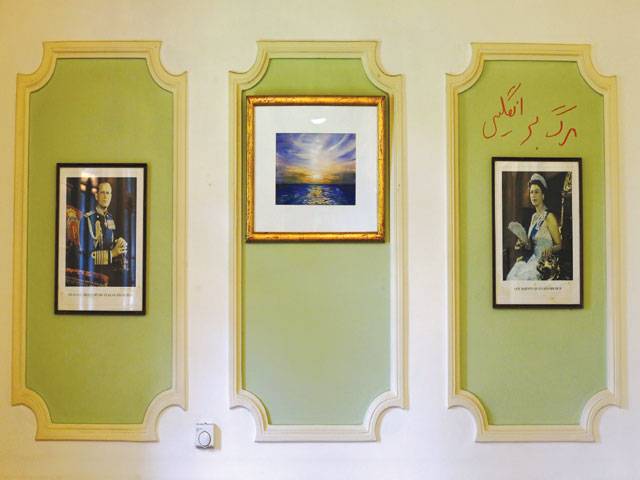Guy Faulconbridge - "Death to England" is scrawled in oddly tidy Farsi above a photograph of Queen Elizabeth on the wall of the 19th Century embassy in Tehran, testimony to the perception here that Britain is a perfidious intriguer in Iranian affairs.
British Foreign Secretary Philip Hammond reopened the embassy in Tehran on Sunday, nearly four years since it was ransacked by protesters who left graffiti across the walls of a building which many in Iran believe is a lair of spies working for the "Old Fox", as Britain is sometimes known.
On the doors to a grand reception room where Winston Churchill held a birthday dinner attended by Joseph Stalin and Franklin D. Roosevelt during the 1943 Tehran conference, writing in red marker pen still reads: "Death to England. Death to Israel. As long as we are alive, we are fighting."
It looks as if someone has tried to wash it off with little effect. A mirror remains smashed in the room where the leaders of Britain, the Soviet Union and the United States discussed their strategy for winning World War Two.
"This embassy and this special compound is a very special place: Since Britain acquired it in 1869, it has witnessed great moments both in the history of Iran and of Britain," said Hammond, the second British foreign secretary to visit Iran since the 1979 revolution toppled the US-backed Shah.
"Reopening the embassy is the logical next move - a key step in building confidence and trust between two great nations," Hammond told embassy staff.
The Union Jack flag was raised in the gardens to conclude the opening ceremony and the embassy perimeter was guarded by dozens of Iranian police.
In 2011, the flag was burned by protesters who looted the embassy and smashed some treasures, prompting Britain to shut it down and order out Iranian diplomats from London.
A portrait of Queen Victoria was torn in two, the head was cut out of a portrait of Edward VII and a picture of Queen Elizabeth was stolen. The portraits of Victoria and Edward are being restored in London. The picture of Elizabeth was last seen being carried by a protester over the gates of the compound.
There had been regular protests outside the British embassy over the years since the 1979 Islamic revolution, but none were as violent as the 2011 storming in response to nuclear-related sanctions from London.
At the time, Prime Minister David Cameron called the attack "outrageous and indefensible" and scolded the Iranian government for failing to defend British staff and protect the building.
Protesters smashed the large stone lion and unicorn on the gates at the elegant ambassadorial residence. It has not been replaced. "The Iranians have always considered this embassy to somehow be a special centre of sort of colonial intrigue in Persian affairs," said one diplomatic source in Tehran.
Built as a symbol of imperial might when Britain was locked into the 'Great Game' struggle for influence with swiftly expanding Tsarist Russia, the embassy has been the subject of much speculation in Tehran. In 2007, Iranian media carried stories of a secret tunnel running under a carpet shop and used to smuggle "spies and prostitutes" into the embassy.
A string of disputes, sometimes bloody, have marked Iran's diplomatic relations with the Great Powers over the years. Alexander Griboyedov, the Tsar's ambassador to what was then Persia, and the entire Russian embassy staff were killed by a mob in 1829 after Persia ceded what is now Georgia, Armenia and some of southern Azerbaijan to the Tsar's growing empire.
The US embassy in Tehran was sacked in the early days of the Islamic Revolution in 1979 by students who feared a repeat of a 1953 coup when the CIA orchestrated the overthrow of Prime Minister Mohammad Mossadegh. The US hostage crisis lasted 444 days and Washington and Tehran have not resumed diplomatic ties.
Churchill had advocated the toppling of Mossadegh, who had nationalized the Anglo-American Oil Company.
In 1980, Britain's elite Special Air Service (SAS) stormed the Iranian embassy overlooking Hyde Park in London after six gunmen demanding the release of Arab prisoners from the southwestern Khuzestan province took 26 hostages inside. Iran thanked Britain for saving all but one of the hostages.
Friday, April 19, 2024
'Old Fox' Britain keeps souvenirs of storming in Tehran embassy

KP minister briefed on issues about sales tax on services
April 19, 2024
64th anniversary of freedom fighter Mirzali Khan marked
April 19, 2024
893,000 students appear in SSC exams in KP
April 19, 2024
Saudi govt shows interest to fund two road projects
April 19, 2024
Moot notes diabetes, blood pressure on the rise among youth
April 19, 2024
Hepatitis Challenge
April 18, 2024
IMF Predictions
April 18, 2024
Wheat War
April 18, 2024
Rail Revival
April 17, 2024
Addressing Climate Change
April 17, 2024
Justice denied
April 18, 2024
AI dilemmas unveiled
April 18, 2024
Tax tangle
April 18, 2024
Workforce inequality
April 17, 2024
New partnerships
April 17, 2024
ePaper - Nawaiwaqt
Advertisement
Nawaiwaqt Group | Copyright © 2024





